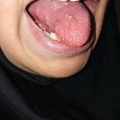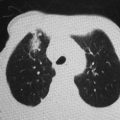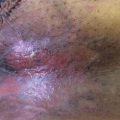, Ahmad Ameri1 and Mona Malekzadeh2
(1)
Department of Clinical Oncology, Imam Hossein Educational Hospital, Shahid Beheshti University of Medical Sciences (SBMU), Shahid Madani Street, Tehran, Iran
(2)
Department of Radiotherapy and Oncology, Shohadaye Tajrish Educational Hospital Shahid Beheshti University of Medical Sciences (SBMU), Tehran, Iran
Radiation esophagitis is an acute dose-limiting toxicity associated with radiation treatment that decreases the patient’s compliance for treatment completion.
Incidence of acute esophagitis has been reported in about 29% of patients with thoracic radiation therapy [1] and in 93% of patients undergoing thoracic chemoradiation therapy [2]. Severe esophagitis requiring nutritional support or radiation therapy breaks has been reported in 1–4% and 22–45% of patients that are treated with radiation therapy alone or chemoradiation therapy, respectively [3, 4].
12.1 Mechanism
The luminal side of the normal esophagus is lined by mucosa. The mucosal layer contains epithelium, lamina propria, and muscularis mucosae. The esophageal epithelium is a nonkeratinizing, stratified, squamous epithelium and contains rapidly dividing cells situated in the basal layer [5].
Table 12.1
RTOG/EORTC esophagitis grading
Definition | |
|---|---|
Grade 1 | Mild dysphagia or odynophagia (may require topical anesthetic or nonnarcotic analgesics and a soft diet) |
Grade 2 | Moderate dysphagia or odynophagia (may require narcotic analgesics and puree or liquid diet) |
Grade 3 | Severe dysphagia or odynophagia with dehydration or weight loss >15% from pretreatment baseline requiring NG feeding tube, IV fluids, or hyperalimentation |
Grade 4 | Complete obstruction, ulceration, perforation, and fistulization |
Radiation therapy affects the basal epithelial cell layer and limits the proliferation rate of the basal epithelium, causing mucosal thinning, ulceration, and initiation of the inflammatory response resulting in congestion, edema, or erosion [6].
12.2 Timing
Acute radiation esophagitis begins on the second to third week after initiation of irradiation (20–30 Gy). Generally, with single daily fractions of 2.0 Gy radiation therapy, grade 1 esophagitis first appears in the second week, and grade 2 and higher esophagitis begins during the third week of the treatment. As treatment continues, the rate of symptomatic esophagitis increases. Patients experience grade 3 esophagitis during the fifth week of treatment [7].
Esophagitis often recovers within 4–6 weeks of treatment completion. The duration of symptomatic esophagitis is longer for intensive treatment (hyperfractionated radiation therapy or concurrent chemotherapy) [8].
12.3 Risk Factors
The most significant predictors of acute esophagitis are concurrent chemotherapy [9–13] and hyperfractionated radiation therapy, especially in the setting of concurrent chemotherapy with hyperfractionated radiation therapy [12, 14–17].
It has been reported that the use of chemotherapy concurrent with irradiation is associated with a nearly 12-fold greater risk of developing severe esophagitis [18]. Sequential chemotherapy seems not to significantly increase the risk of esophageal radiation injury [3, 4, 14, 19]. The incidence of esophagitis in chemoradiotherapy is also dependent on chemotherapeutic agents used. Cisplatin-based regimens are generally associated with a lower rate of significant esophagitis compared with protocols using paclitaxel [7, 20, 21].
Radiation regimen schedule is an important factor in the rate of esophagitis. Higher radiotherapy dose per fraction [22] and increasing the number of daily fractions induce more severe esophagitis.
A number of studies evaluating dosimetric factors have shown that percentage of esophagus volume receiving 10–60 Gy [7, 9, 23–30], mean esophageal dose [24, 25, 31], the maximal esophageal dose [11, 13, 32], esophageal surface area receiving 55 Gy [9], and higher length of the esophagus in the radiation treatment field (with some contradictory results) [6, 15, 33] are all associated with acute esophagitis.
A recent systematic literature review concluded that the valuable dosimetric parameters predicting the occurrence of acute radiation esophagitis in patients receiving concurrent chemoradiotherapy include maximum esophageal dose, mean esophageal dose, and esophageal volume receiving 20, 30, 50, and 55 Gy [34].
It is well known that with the similar dosimetric parameter consideration, only a small proportion of patients develop esophageal toxicity. Individual variability in radiosensitivity should be further investigated to identify genetic variations modulating the development of radiation esophagitis. In this regard, it has been observed that patients with the transforming growth factor-beta1 (TGFβ1)509 CC genotype [35], heat shock protein beta-1 (HSPB1) CC genotype [36], and single nucleotide polymorphisms (SNPs) in inflammation-related genes including three PTGS2 (COX2) variants rs20417, rs5275, and rs689470 [37] are at greater risk for developing radiation esophagitis.
It has been shown that one of the most significant risk factors for dysphagia during chemoradiation is the maximal grade of neutropenia. Indeed, the nadir of the neutrophil granulocytes during treatment is strongly associated with developing and severity of esophagitis [17, 38]. Patients with higher pretreatment platelet counts and lower hemoglobin levels as a preexisting systemic inflammatory state have greater rates of radiation esophagitis [39].
There are individual case reports demonstrated that patients with human immunodeficiency virus (HIV) may experience unusually severe radiation-induced esophagitis [40, 41].
Other factors proposed to be associated with acute esophagitis include the pretreatment body mass index [30].
12.4 Symptoms
Radiation-induced esophagitis presents with retrosternal or substernal burning sensation, pain, odynophagia, dysphagia, and anorexia. Weight loss could occur and nutritional support may be needed. Rarely, with severe esophagitis, patients may develop obstruction, perforation, or fistulas.
12.5 Scoring
12.6 Diagnosis
Radiation esophagitis is a clinical diagnosis in patients with dysphagia or odynophagia, that is, receiving thoracic irradiation. In patients with symptoms progressing after completion of radiation therapy despite the optimal treatment, endoscopy should be considered to establish the diagnosis and rule out other etiologies like infectious or fungal esophagitis.
12.7 Prevention
Prediction of esophagitis severity allows prevention of esophagitis with treatment deintensification and other measurements. Various dose constraints are proposed to predict radiation-induced esophageal toxicity that should be considered in treatment planning.
It has been shown that esophagitis as an inflammatory process results in elevated 18F-fluordeoxyglucose (FDG) positron emission tomography (PET) uptake in the postradiation period, which correlates to the treatment planning dose distribution. Using posttreatment 18F-FDG-PET scans allows for developing a quantitative biological model to improve the accuracy of esophagitis prediction based on planned dose [44]. Also an increase in FDG uptake during radiation therapy from pre-radiation may predict radiation esophagitis and provides the opportunity for treatment planning modification [45].
Advances in the radiation delivery with intensity-modulated radiation therapy (IMRT) may allow radiation oncologists to prescribe higher doses to tumors with normal structures being spared such and keep the incidence of radiation-induced esophagitis quite low when the esophagus is not the treatment target [11, 46].
Amifostine is an organic thiophosphate compound that offers selectively normal cell protection from radiation-induced damage and also chemotherapeutic agents by scavenging oxygen-derived free radicals [47]. It seems that amifostine administration can protect the normal esophageal mucosa from radiation-induced injury and delay the onset of esophagitis and reduce its severity and incidence.
In a multicenter trial of 146 patients with advanced lung cancer treated with a daily fractionated radiation therapy to a total of 55–60 Gy with or without daily amifostine administration reported that the incidence of esophagitis grade 2 or higher was 42% in the radiation therapy alone group versus 4% in the group with amifostine administration during 4 weeks of treatment [48].
Amifostine administration seems to reduce severe esophagitis and analgesic intake in patients undergoing chemoradiation therapy without compromising treatment outcomes [20, 49–51]. Further studies are required to determine the optimal amifostine combination with therapeutic strategy.
Glutamine supplement administration during thoracic irradiation appears to postpone onset and reduce the severity of radiation esophagitis [52]. Further investigation of this agent may therefore be warranted.
Oral sucralfate solution has been compared with placebo as prophylaxis in a prospective trial and didn’t prevent esophagitis development, although it had significant gastrointestinal side effects [53].
12.8 Management
Acute esophagitis is managed symptomatically.
Dietary modification that should be recommended to all patients are:
Eat frequent meals with small pieces throughout the day instead of three large meals.
Eat soft foods that are warm or at room temperature.
Drink enough liquids.
Avoid hot or spicy foods, acidic foods, and hard and crunchy foods.
Avoid alcohol and tobacco.
Pain is managed with topical analgesics (e.g., viscous lidocaine), NSAIDs, or narcotics.
If patients complain of reflux symptoms, antacids, proton-pump inhibitors, or H2 receptor blockers could be effective.
In the setting of severe dysphagia or odynophagia with significant weight loss, short breaks from radiation therapy have been proposed. Feeding tube or parenteral nutrition may be needed for these patients (see Sect. 6.7.5).
References
1.
2.
3.
Dillman RO, Seagren SL, Propert KJ, Guerra J, Eaton WL, Perry MC et al (1990) A randomized trial of induction chemotherapy plus high-dose radiation versus radiation alone in stage III non-small-cell lung cancer. N Engl J Med 323(14):940–945CrossRefPubMed
Stay updated, free articles. Join our Telegram channel

Full access? Get Clinical Tree






